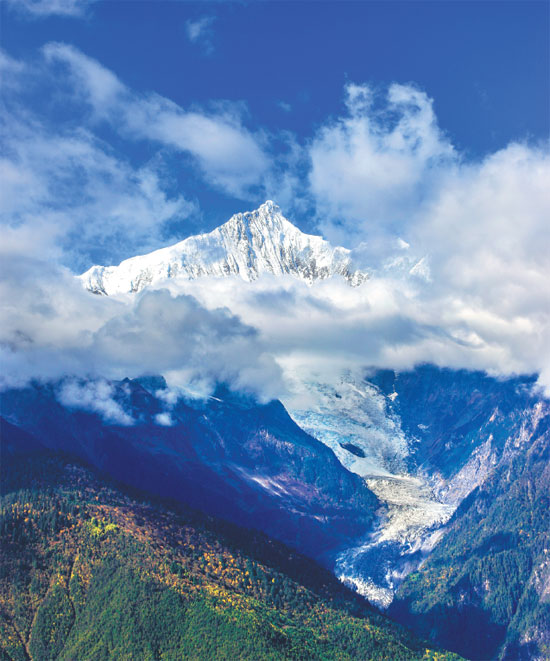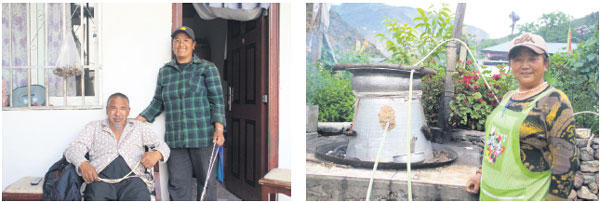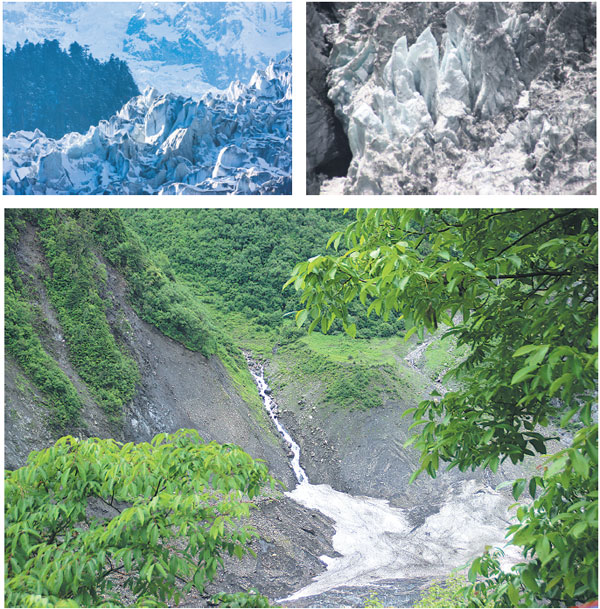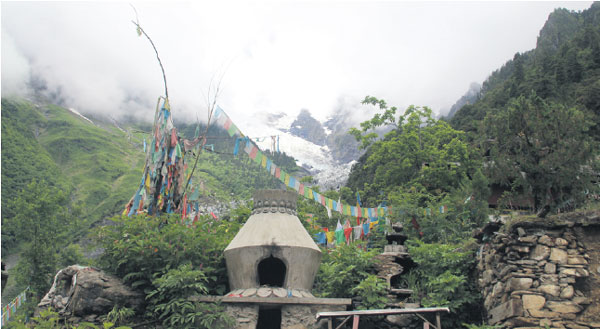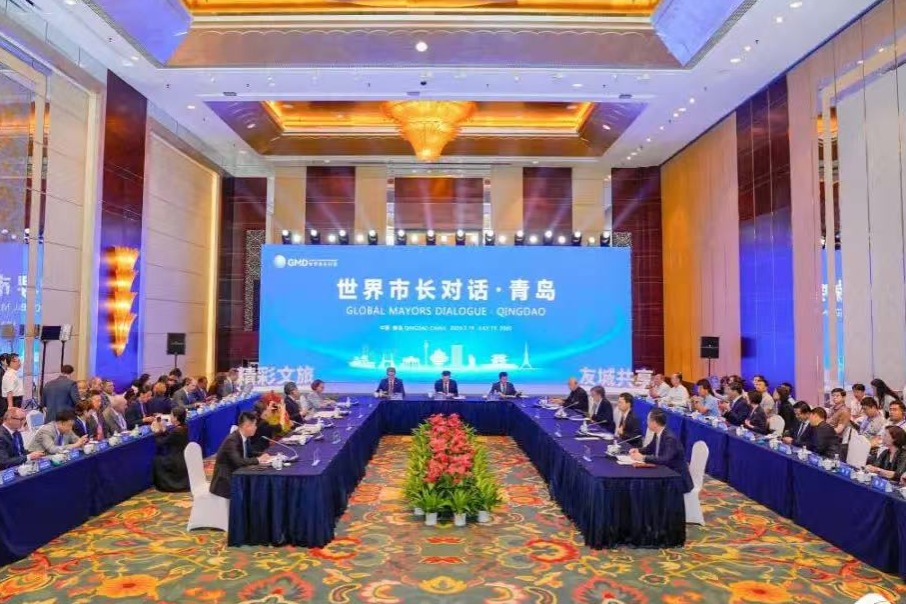The great thaw

An elderly woman clutches two sticks as she walks up the narrow path of a mountain in the Meili range in Deqen county, Yunnan province, on a recent weekday.
Catching her breath from time to time, she follows her younger companions on the 4-kilometer trek, which is often interrupted by herds of ponies carrying cement and rocks for repair work at a temple that pilgrims like her seek to visit. Prayer banners of different colors flutter in the wind above their heads.
Their climb will not end until they have reached a higher observation deck from which Mingyong Glacier is visible in its full splendor.
Located in Southwest China at an elevation of nearly 3,000 meters above sea level, the glacier - a sacred site in Tibetan Buddhism - draws hundreds of pilgrims and tourists from home and abroad each year. For locals, it is a source of fresh water that feeds several streams in the province's northwest and can be used for irrigation and drinking.
| Mingyong Glacier, located on a subsidiary peak of the Meili Snow Mountain in Yunnan province, in October 2009. Xu Dong / For China Daily |
| Baima Dengzhu and his wife live in the foothills; Cili Kazhu, a 57-year-old resident, recalls "collecting ice" from glaciers in her youth. |
| Mingyong Glacier sits at an elevation of nearly 3,000 meters above sea level. The glacier has receded about 300 meters between 1975 and 2009, an expert says. An icy trickle (above) near the Mingyong Glacier. |
| A majority of China's 48,570 or so glaciers are on the Qinghai-Tibet Plateau. The country's total glacial area had shrunk to some 50, 000 sq km by 2010, an estimated 17 percent reduction, an expert says. Photos by Shi Wenzhi and Satarupa Bhattacharjya / China Daily |
But all this could change in coming decades. The lowest-lying of China's 48,570 or so glaciers, Mingyong has long been in a state of retreat.
"The glacier has receded about 300 meters at the end and in height from 1975 to 2009, which means it has shrunk overall from 12.64 square kilometers to 12.38 sq km," Liu Shiyin, a glaciologist from Yunnan University in Kunming, tells China Daily in a written response to questions.
Twelve other glaciers to the east of the Lancang River, which flows from the Qinghai-Tibet Plateau throughYunnan to five countries (as the Mekong), have thinned since 1968. The majority of China's glaciers are on the plateau. The country's total glacial area had shrunk to about 50,000 sq km by 2010, an estimated 17 percent reduction, Liu says.
The rates of pullback and contraction, among other changes over 50 years, have varied from glacier to glacier. And while within the world scientific community there might be various opinions on the health of glaciers, measured largely by satellite data or on-site monitoring, there is little disagreement over what has triggered the great thaw.
"Glaciers have experienced a universal retreat since the mid-19th century," Liu says. "But the acceleration in shrinkage has become more apparent in recent times."
Climate change, commonly known as global warming, is caused by man-made and natural activities, and glaciers are sensitive to it.
The Industrial Revolution contributed substantially to climate change, experts say.
According to a paper by the Institute of Tibetan Plateau Research, an affiliate of the Chinese Academy of Sciences, glacial retreat in China has been noticed more among small mountain glaciers in the southwest of the Tibet autonomous region, where the mass deficit has been increasing since the 1970s.
Village in the foothills
Deqen county, which is part of the Diqing Tibet autonomous prefecture, has a forested area that is among the world's richest in biodiversity. The valley's surrounding mountains are home to rare species, such as the snub-nosed monkey, snow leopard and Tibetan pheasant. The vegetation in this part of Yunnan straddles the temperate and tropical worlds.
The melting of Mingyong Glacier will likely affect the local flora and fauna, and the river ecosystem in the long term.
For domestic animals like yaks, which are used to life at high altitudes, an eventually warmer place would alter their natural environment and increase the risks of infectious diseases, says Nasheng Duji, a senior official with the county government's agriculture bureau in the town of Deqen.
In addition, local livestock farming relies on natural pastures, which support the livelihoods of about 58,000 people in the county. A change in the weather pattern - less snow - is already showing signs of grassland degradation. Nasheng Duji says the county has provided a subsidy since 2011 to deal with this ecological issue.
"Global warming will also lead to the gradual reduction of the area's permafrost, a part of which still depends on the glacier. But it could dry up in the future and affect the growth of plants," says Wei Guodong, another local official.
Mingyong village, where about 300 people live, lies in the foothills of the glacier. Many rural residents are farmers who grow and sell corn, highland barley, grapes, nuts, olives and pine mushroom, as well herbs for use in traditional Chinese and Tibetan medicines. A few others have opened inns and restaurants to cater to tourists.
A small river fed by the glacier runs through the village and enriches the soil.
"I used to collect ice from the glaciers here," Cili Kazhu, 57, says of her younger days when she spent time around smaller glaciers in the vicinity.
They have thinned in the past 30 years or so, she says while stirring hot barley liquor in the yard of her house.
Tibetans make up the majority of the population in this county of 67,000 people.
Baima Dengzhu, a 65-year-old man who migrated to Mingyong village from Northwest China's Qinghai province a few years ago to work at a Buddhist temple, describes the glacial retreat as a "process of nature". But he says people in the village are planting more trees to keep things green.
Among the younger villagers, the men are involved with roadwork or tourism, while the women either study or work outside.
"The temperatures have risen (in the area)," says Dinzhen Zhaba, a 27-year-old excavator operator.
Views on global warming
Glacial ice is considered to be the largest reservoir of fresh water on Earth. According to a world inventory, there are 198,000 known glaciers.
According to some experts in China, "high-mountain Asia" has 94,000 glaciers, the largest number outside the polar region. These feed many important rivers, such as the Yangtze, Yellow, Ganges, Brahmaputra, Indus and Mekong, which supply water to more than 1 billion people.
Most of these glaciers have melted over recent decades at an average rate of nearly 1 percent, with temperature and precipitation mainly influencing the process, they say.
"If the ice from such banks is depleted, there will not be enough water in 100 years for the purpose of irrigation (in parts of Asia)," says John Moore, chief scientist at the College of Global Change and Earth System Science at Beijing Normal University.
Glacial runoff could also lead to flooding in some places and interfere with rainfall. Some attribute the rise in sea levels to melting glaciers, while others say it is due to global warming.
Scientific equipment has indicated that ocean temperatures have increased in the past 30 or 40 years, causing land ice and ice sheets to melt further.
"All of this will affect the balance of energy in nature in the long term," says Li Xichen, a senior researcher at the Institute of Atmospheric Physics, an affiliate of the Chinese Academy of Sciences.
The world's coastal areas will likely take the worst hit.
Li, who has studied the Antarctic and Arctic oceans, says that in western Antarctica, for instance, surface temperatures have also gone up by 5 degrees.
The Antarctic region has about 500 gigatons of fresh water in glaciers.
With glacial melting potentially irreversible, one way to deal with the situation is to pursue sustainable development, experts say. The 2015 Paris Agreement, which seeks to rein in global warming, has been ratified by most countries.
Some experts are suggesting climate modeling as a supplement to emission cuts to combat global warming.
A drastic reduction in greenhouse gas emissions would be needed in the next few decades to limit the global temperature rise to 1.5 or 2 C, experts have said.
"If such targets are met, then it is conceivable that plausible quantities of sulfate aerosol geoengineering may be able to maintain 2020 temperatures throughout the 21st century," Zhao Liyun, a junior scientist at the College of Global Change and Earth System Science at Beijing Normal University, wrote in a recent paper that she co-authored with four others.
satarupa@chinadaily.com.cn
(China Daily European Weekly 07/14/2017 page1)
Today's Top News
- Mayors from around the world gather in Qingdao for dialogue
- Premier announces construction of Yarlung Zangbo hydropower project
- Digital countryside fueling reverse urbanization
- 'Sky Eye' helps unlock mysteries of the universe
- China offers LAC development dividend
- Future sectors to receive more play
















